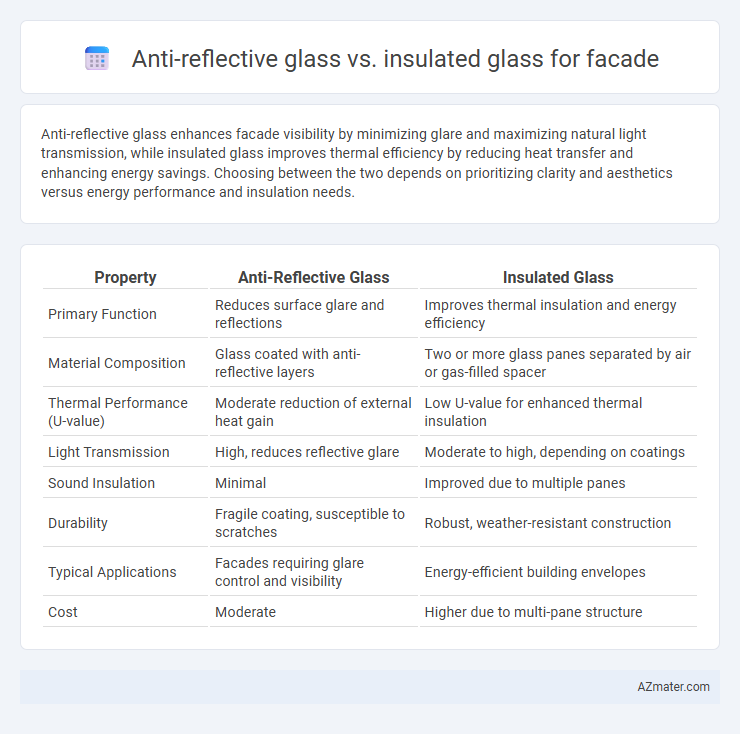Anti-reflective glass enhances facade visibility by minimizing glare and maximizing natural light transmission, while insulated glass improves thermal efficiency by reducing heat transfer and enhancing energy savings. Choosing between the two depends on prioritizing clarity and aesthetics versus energy performance and insulation needs.
Table of Comparison
| Property | Anti-Reflective Glass | Insulated Glass |
|---|---|---|
| Primary Function | Reduces surface glare and reflections | Improves thermal insulation and energy efficiency |
| Material Composition | Glass coated with anti-reflective layers | Two or more glass panes separated by air or gas-filled spacer |
| Thermal Performance (U-value) | Moderate reduction of external heat gain | Low U-value for enhanced thermal insulation |
| Light Transmission | High, reduces reflective glare | Moderate to high, depending on coatings |
| Sound Insulation | Minimal | Improved due to multiple panes |
| Durability | Fragile coating, susceptible to scratches | Robust, weather-resistant construction |
| Typical Applications | Facades requiring glare control and visibility | Energy-efficient building envelopes |
| Cost | Moderate | Higher due to multi-pane structure |
Introduction to Façade Glass Technologies
Anti-reflective glass enhances facade visibility by reducing surface glare and increasing light transmission, improving aesthetic appeal and occupant comfort. Insulated glass units (IGUs) provide thermal insulation through multiple glass layers separated by a gas-filled cavity, optimizing energy efficiency and climate control in building envelopes. Combining these technologies in facade applications balances visual clarity with superior thermal performance, meeting modern architectural and environmental standards.
What Is Anti-Reflective Glass?
Anti-reflective glass reduces surface glare by minimizing light reflection, enhancing transparency and visual clarity on building facades. This type of glass is coated with multiple layers of special materials that improve natural light transmission and reduce external reflections, making it ideal for modern architectural designs. In comparison, insulated glass primarily focuses on thermal performance by trapping air or inert gas between panes to improve energy efficiency and temperature control.
What Is Insulated Glass?
Insulated glass consists of two or more glass panes separated by a sealed air or gas-filled space to enhance thermal performance, reducing heat transfer and improving energy efficiency in facades. Anti-reflective glass minimizes surface reflections to increase light transmission and visibility but does not provide the same thermal insulation as insulated glass. Combining insulated glass with anti-reflective coatings can optimize both energy savings and visual clarity for building facades.
Key Benefits of Anti-Reflective Glass for Façades
Anti-reflective glass enhances facade transparency by minimizing surface reflections, resulting in superior natural light transmission and improved building aesthetics. It reduces glare, boosting occupant comfort and visibility while maintaining thermal efficiency when combined with insulated glass units. This advanced glazing solution supports energy savings and sustainability goals by optimizing daylight usage without compromising insulation performance.
Advantages of Insulated Glass in Building Envelopes
Insulated glass offers superior thermal performance by reducing heat transfer through building facades, significantly improving energy efficiency and lowering heating and cooling costs. Its enhanced sound insulation properties contribute to a quieter indoor environment, while the durable sealed units prevent condensation and moisture buildup, preserving the integrity of building envelopes. Compared to anti-reflective glass, insulated glass provides a more robust solution for maintaining indoor comfort and long-term facade durability in commercial and residential constructions.
Thermal Performance: Anti-Reflective vs Insulated Glass
Insulated glass offers superior thermal performance for facades by reducing heat transfer through its multi-pane design and insulating gas fill, which significantly enhances energy efficiency. Anti-reflective glass primarily improves visual clarity and reduces glare but has limited impact on thermal insulation compared to insulated glass. Facades utilizing insulated glass benefit from lower heating and cooling costs due to its enhanced thermal resistance properties.
Light Transmission and Visual Comfort Comparisons
Anti-reflective glass enhances light transmission by minimizing glare and reflections, improving visual comfort in facades through clearer views and reduced eye strain. Insulated glass, composed of multiple panes with an air or gas-filled gap, provides superior thermal performance but may slightly lower visible light transmission due to the additional layers. Selecting between these glasses depends on prioritizing higher natural light and clarity with anti-reflective glass or better energy efficiency and acoustic insulation with insulated glass.
Energy Efficiency Considerations
Anti-reflective glass enhances facade energy efficiency by maximizing natural light transmission while minimizing glare and solar heat gain, reducing the need for artificial lighting and cooling. Insulated glass units consist of multiple panes separated by a spacer and sealed to improve thermal insulation, significantly lowering heat transfer and boosting the building's overall energy performance. Combining anti-reflective coatings with insulated glass can further optimize facade energy efficiency by balancing daylight access and thermal regulation.
Cost and Maintenance: Which Glass Is More Practical?
Anti-reflective glass typically costs more upfront due to advanced coatings that reduce glare and improve visibility, but it demands less frequent cleaning, lowering long-term maintenance expenses. Insulated glass offers better thermal efficiency, which can reduce energy costs, though seals can degrade over time, requiring occasional maintenance or replacement. For facade applications prioritizing cost-efficiency and low upkeep, anti-reflective glass is more practical, while insulated glass excels in energy savings despite potentially higher maintenance demands.
Choosing the Right Glass for Your Façade Project
Anti-reflective glass enhances clarity and reduces glare, improving visual comfort for building occupants and boosting aesthetic appeal on facades where transparency is key. Insulated glass, composed of multiple panes with a gas-filled cavity, provides superior thermal performance by minimizing heat transfer and increasing energy efficiency in facade applications. Selecting the right glass depends on balancing priorities such as energy savings, light transmission, glare reduction, and overall facade design requirements.

Infographic: Anti-reflective glass vs Insulated glass for Facade
 azmater.com
azmater.com